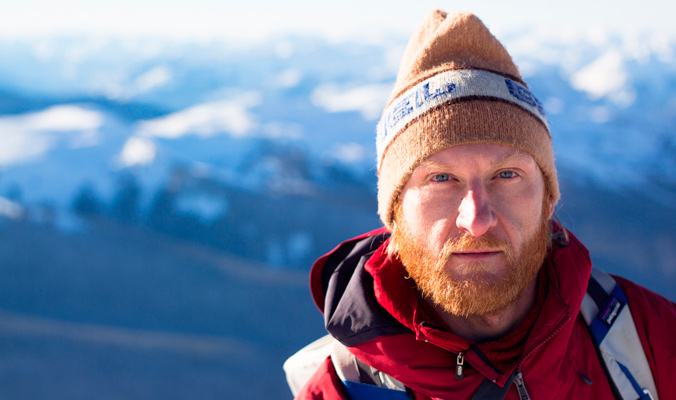
Spearhead doctor and blueberry farmer JD Hare atop Mt. Trorey, B.C. [Photo] Vince Shuley
He may spend the summer months tending blueberry bushes, but JD Hare is far from being put out to pasture.
In 1996, at age 18, Hare came achingly close to ascending Canada’s tallest peak, Mt. Logan, but turned back just shy of the 19,551-foot summit when altitude sickness affected most of his party. While that mission would have made Hare the youngest person to summit Logan, it still helped propel his freeskiing career toward steep and creative lines. But his inclination to migrate west from his native Ontario was sparked much earlier.
“Back in 1992, when I was growing up in uptown Toronto, my stepbrother sent me a T-shirt from his travels in Whistler,” Hare, now 40, recalls. “On the back was a cartoon drawing of the wild ‘Spearhead Traverse,’ and [it] listed the prominent peaks in the range.”
Whistler—in particular its neighboring peaks—became his training ground after he moved there in 1997, cutting his teeth in the Spearhead Range. “I was trying to get noticed and sponsored, so I spent as much time as I could honing my big-mountain skills,” he says. “I fanned out from the Whistler and Blackcomb resort boundaries, started camping overnight, doing massive day trips and the odd solo mission.”
Along with professional snowboarder Kevin Smith, Hare spent the early 2000s chalking up first descents in British Columbia’s Coast Range and on exploratory trips to Georgia and Kyrgyzstan. The risks soon caught up with him, however, with three consecutive injuries to his right leg from 2005 through 2006. Hare recovered to scratch his seemingly eternal itch, checking off three of his career’s most intimidating Coast Range lines: in 2007 he skied 13,186-foot Mt. Waddington’s Four Horsemen Couloir, then, three years later, Ivory Shoulder on Alpha Mountain (7,552 ft.) and the backside of Mt. Dione (8,494 ft.), known as Middle Earth—completed together in a 23-hour push.
“JD has always been looking for the aggressive lines that other skiers might question, and when he does pull it off, he does so with style,” Smith says. “Everyone has a different tolerance of risk, but he’s pretty calculated. Add a lot of strength and endurance plus a great set of mountaineering skills, and you have a backcountry partner you can pretty much ski anything with.”
Around 2009, Hare began feeling ready to settle down in Pemberton with his wife, Sharon, to focus on their family. So he stepped back from steep, remote mountains and into their five-acre, certified-organic blueberry patch. Hare’s Farm blueberries shot to fresh-produce fame in the Sea to Sky Corridor, but his adopted home turf of the Spearhead Range still beckoned.
“With a well-earned global perspective, I could appreciate the Pacific coast as one of the absolute premier regions for big-mountain skiing in the world,” Hare says. “So with a growing family and no more travel budget, I decided to ski the shit out of the Spearhead.”
As family and farm responsibilities ramped up, he used the winter months to their fullest while his fields lay idle under snow cover. After dropping his son, River, off at ski school, Hare would power into the Spearhead and tick off lines that had eluded him. Sharon would pick up River from ski school, allowing Hare to return from the mountains by headlamp.
The reacquaintance with Whistler’s peaks inspired him to pursue the most aesthetic line from all 20 Spearhead summits, something that few Whistler skiers have attempted and no one had completed. In spring 2017, after descending the west face of The Ripsaw (8,671 ft.), Hare finally checked the final box on his Whistler bucket list, an achievement that’s earned him the title of the “Spearhead Doctorate.”
Now with a steep-skiing résumé as long as his arm and having experienced more than his share of close calls, Hare isn’t looking for risk to inspire his life’s next phase. While his second son, Raif, learns skiing’s ropes, River is nearing the age of backcountry readiness. But Hare is the first to admit that the steep-skiing bug will never disappear.
“I measure the success of these endeavors by how indelibly the memory rests in my mind,” he says. “Around here [in Whistler and Pemberton] we don’t have a lot of huge faces, so for me the aesthetic comes from the steeper line. I’m captivated by it, and I want to commune with it.”










Related posts:
The Trendsetter: How Diny Harrison, the first North American woman to earn an international mountain…
Return to Evil: Hilaree Nelson revisits oblivion to ski India’s 21,252-foot Papsura
Illusions of Safety: After a friend’s avalanche death, a lesson in intuition
The Backside of Beyond: An essay by the late Allan Bard